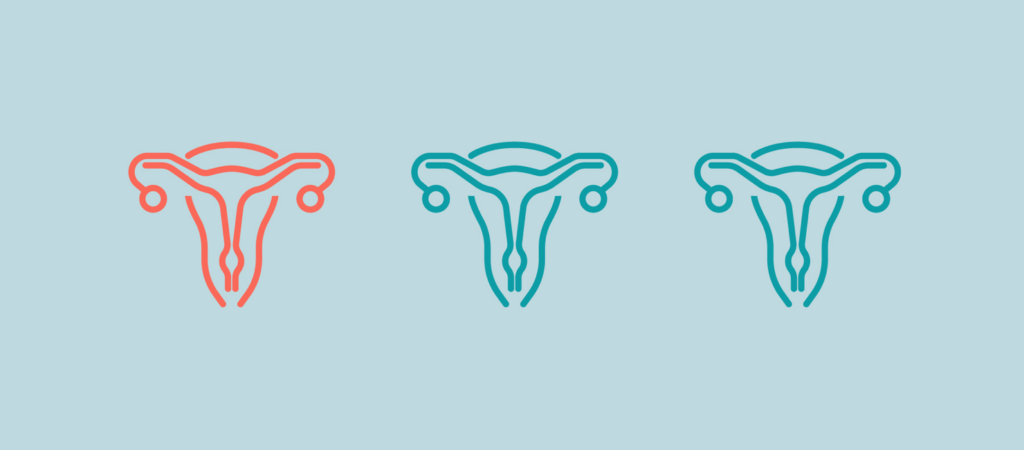Birth Control and Uterus Didelphys
Two uteruses, two cervixes, and sometimes two vaginas. It’s called uterus didelphys, and it requires special considerations when choosing birth control, getting pregnant, and carrying to term. The experts at Nurx want you to understand the specifics of using contraception, given the unique characteristics of this condition.
What Is Uterus Didelphys?
Often referred to as double uterus or uterine duplication, uterus didelphys is a rare congenital abnormality, affecting one in approximately 3,000 women.
In a developing female fetus, two tubes usually connect to create one organ, the uterus. When the tubes don’t join properly, two separate structures develop. A double uterus might have one opening — the cervix — leading to one vagina. Or, each uterine cavity can have a cervix. In some cases, there can be two vaginas or canals that extend from the outside female genitalia to the cervixes.
How Is Uterus Didelphys Discovered?
Most women with uterine duplication are asymptomatic. That was the case for 32-year-old Elaine* of Morgantown, West Virginia. She did not know she had a double uterus until her first pelvic exam at 18 years old.
“My doctor found two cervixes, thus two uteruses,” said Elaine, a family nurse practitioner who is now a stay-at-home mom. “At age 26, I had an MRI, which confirmed two uteruses and two cervixes with a complete septum dividing the two.”
What Are the Symptoms?
While uterus didelphys often reveals itself during a routine pelvic exam, other scenarios could lead to its discovery. Symptoms can include abnormal pressure or cramping pain before or during a period, an unusually high amount of menstrual bleeding, repeated miscarriages, or preterm labor.
“A portion of women with double uterus only have one kidney,” Elaine added. “The kidneys and the uterus form at the same time in the womb. With the uterus being misdeveloped, the kidneys are sometimes, too. I am lucky to have two kidneys.”
How Does Uterus Didelphys Affect Periods?
A woman with a double vagina might experience menstrual bleeding that isn’t stopped by a tampon. This happens when she has placed a tampon in one vagina, but the blood is exiting from the other.
In addition, uterus didelphys is associated with endometriosis, a disorder characterized by painful periods.
“My periods have always been extremely severe — heavy cramps and PMS,” Elaine said. “I was diagnosed with PMDD, and it is strongly believed I have endometriosis. However, I do not know if this is in correlation to the double uterus.”
Elaine also suspects that her two uteruses alternate thickening and shedding, with the left uterus bleeding one month and the right uterus, the next. “I think they alternate because every other month is more severe,” Elaine said. “But, I have no medical confirmation.”
What Does Uterus Didelphys Mean for Birth Control and Pregnancy?
Combination birth control is effective for women with uterine duplication. A great place to learn more is Nurx, which offers many combination birth control choices, including the pill, patch, and ring. The hormones in birth control suppress ovulation, just as they do for women with a single uterus.
“I have used multiple pills, the ring, and the patch,” Elaine said. “Of those, my personal preference was the ring only because of ease of use. I’ve also used condoms and natural family planning and prefer natural family planning. I am not a candidate for an IUD due to the two uteruses.”
While it is possible to get pregnant in both uteruses, Elaine said it would be “extremely rare.” Once pregnant on one side, women with uterus didelphys cannot get pregnant on the other side. This is because the body stops ovulating after conception. However, uterus didelphys can cause struggles with fertility, miscarriage, and preterm labor.
“I always knew I wanted kids, and being told that miscarriages may be inevitable and that I may not be able to carry a pregnancy were scary things to hear,” said Elaine. “My boyfriend at the time, now my husband, was very supportive, reassuring me one way or another, we would have a family. My family was supportive, too. My sister went as far as saying she would be willing to be a surrogate. I believe I would’ve adopted before using a surrogate, but just hearing her say that made me feel so good.”
Despite the possible complications, Elaine has had two full-term pregnancies that resulted in healthy babies, both conceived in the left uterus after less than six months of trying.
“I feel incredibly lucky I’ve had two healthy pregnancies and babies,” she said.
This blog provides information about telemedicine, health and related subjects. The blog content and any linked materials herein are not intended to be, and should not be construed as a substitute for, medical or healthcare advice, diagnosis or treatment. Any reader or person with a medical concern should consult with an appropriately-licensed physician or other healthcare provider. This blog is provided purely for informational purposes. The views expressed herein are not sponsored by and do not represent the opinions of Nurx™.







